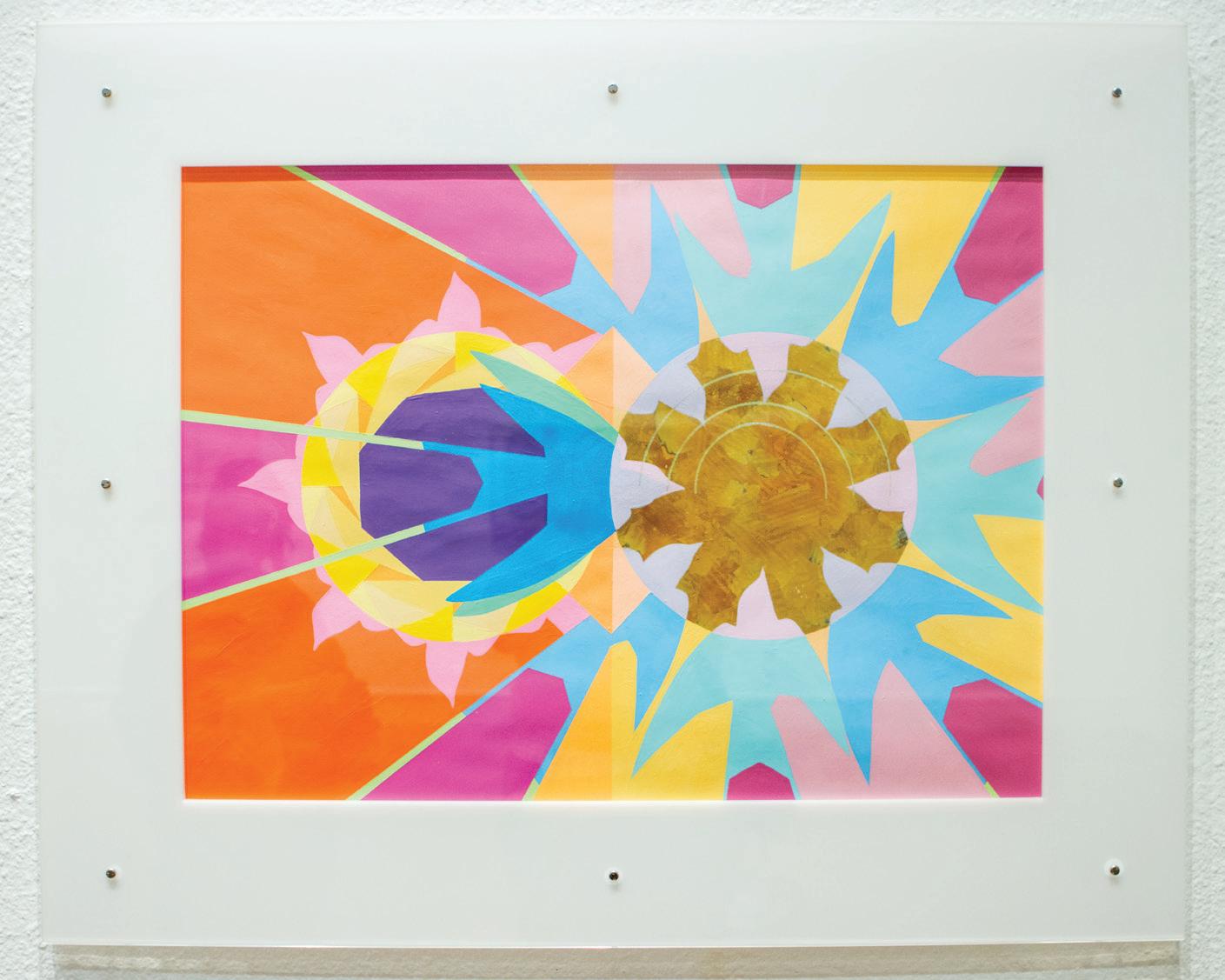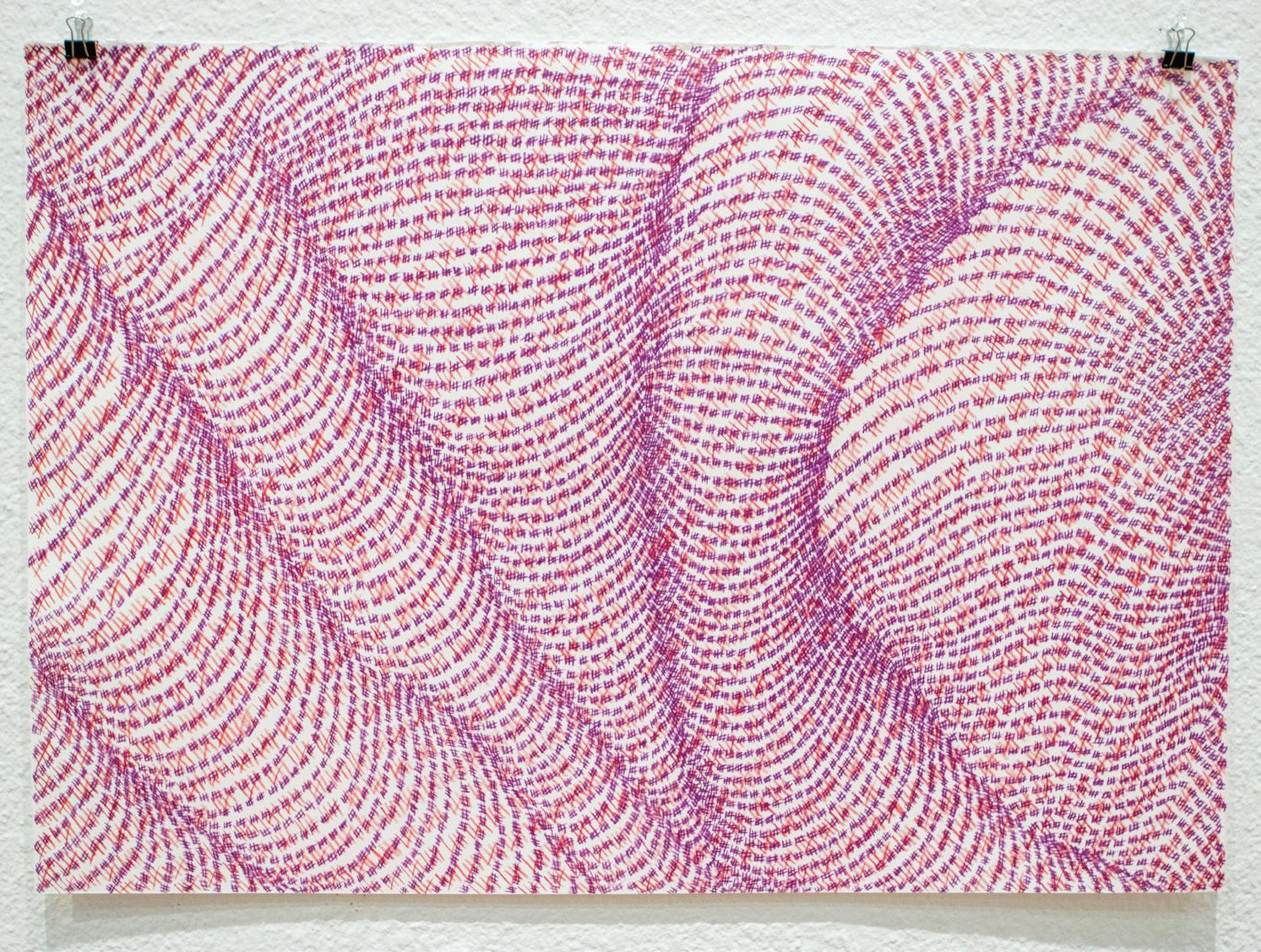Wednesday, February 5, 2025 – Volume 38 Issue 14
Exploring Braille’s importance now
Lighthouse for the Blind of Fort Worth hosts Braille awareness event
DIEGO COLLAZO campus editor diego.collazo@my.tccd.edu
Students and faculty gathered Jan. 29 on South Campus to learn about the significance of Braille and accessibility challenges faced by individuals with visual impairments.
Amanda Guerrero, an orientation and mobility specialist at the Lighthouse for the Blind of Fort Worth, emphasized the importance of Braille literacy along with assistive technology. Attendees learned about legal protections, gaps in accessibility and misconceptions surrounding blindness.
According to the Centers for Disease Control and Prevention and the Health Policy Institute, visual impairment and blindness are among the top 10 disabilities, with approximately 20 million Americans and 3% of children suffering from some kind of visual impairment.
Guerrero said in a world full of technological advancements, Braille is more important than ever before.
DISTRICT
Dual credit now at adult high school
FRED NGUYEN campus editor collegian.editor@tccd.edu
New Heights Adult High School has entered the next stage in its partnership with TCC by beginning to offer dual credit courses to its students.
The TCC Board of Trustees approved the formal agreement during its Jan. 23 meeting, and students have already been enrolled in classes, according to district director of educational partnerships Edward Hicks.
South Campus President Daniel Lufkin provided an update on the school’s progress during the Jan. 16 Board of Trustees work session.
The school, which opened in early September of last year, started its first term with over 500 students. Now in its third term, the school currently enrolls 600 students and has a waiting list of over 520. With a retention rate of 82%, Lufkin said New Heights is “demonstrating strong student engagement and satisfaction.”
Student outreach and partnership manager Ricky Martinez said that while there have been a few drops, students are excited to be at New Heights.
“You see the same faces all the time,” he said. “So we’re excited to be here. We just want to be part of their journey.”
One of the new faces is Ancharnita Hunter, an administrative assistant at a life insurance company who wants to further her career in finance by getting higher education.
She has been attending New Heights for a few weeks and said she loves the experience so far, especially since the school provides child care for her 3-year-old, Tyme, while she takes her classes.
Hunter heard about the dual credit courses available at New Heights in her career development class. She said she looks forward to taking it and that the program will affect her life in a positive way.
“It’ll put me places where I once couldn’t go,” she said.
According to a 2022 publication by the U.S. Bureau of Labor Statistics, workers aged 25 and over with a high school diploma earn 25% more than workers without high school diplomas.
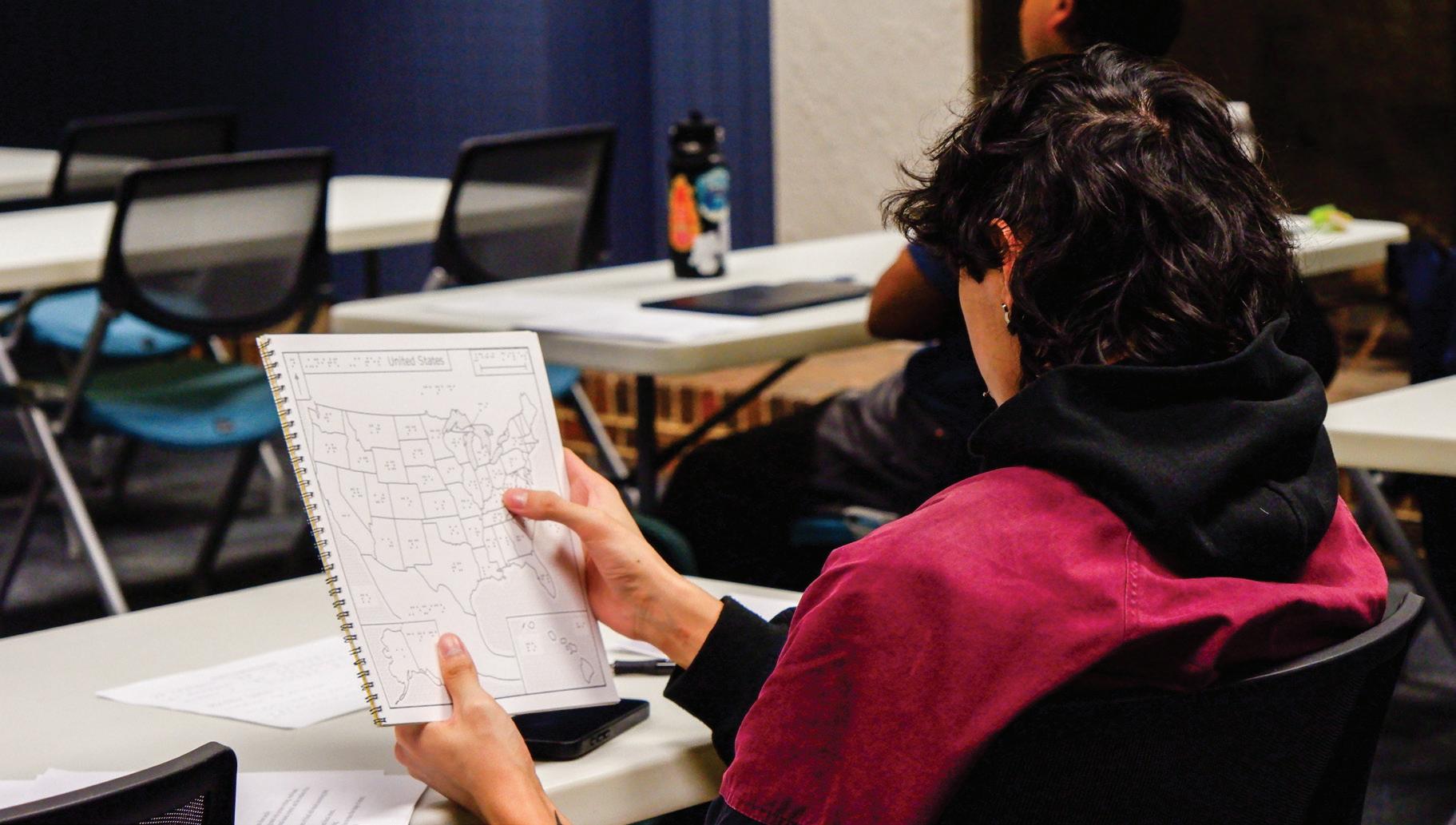
“Braille is literacy, and it’s one of those use-it-or-lose-it skills,” Guerrero said. “So, we want to make sure students are training their
Braille skills in case they aren’t able to access the technology.”
According to the American Foundation for the Blind, the aver-
age cost for a refreshable Braille display is between $2,000 and $4,000, with more advanced options exceeding $5,000.
English instructor Mary Sabotin said she also believes in the importance of literacy and learning the skills necessary to live independently.
“If you’re in a situation where you can’t see, learn it,” Sabotin said. “It never hurts to have the knowledge because you might be able to help somebody else.” Laws like the Americans with Disabilities Act of 1990 and the Education for All Handicapped Children Act of 1975 protect the rights of those with disabilities, including people with visual impairments. Nonetheless, Guerrero said gaps still need to be filled in people’s understanding of Braille.
“Accessibility is a big issue,” Guerrero said. “I’ve seen interactions that make students feel small and put them in a shell.”
Restaurants aren’t required by law to have Braille menus, and Guerrero said that can lead to some issues.
“Some restaurants have them, but that’s the bare minimum,”
south campus art exhibition
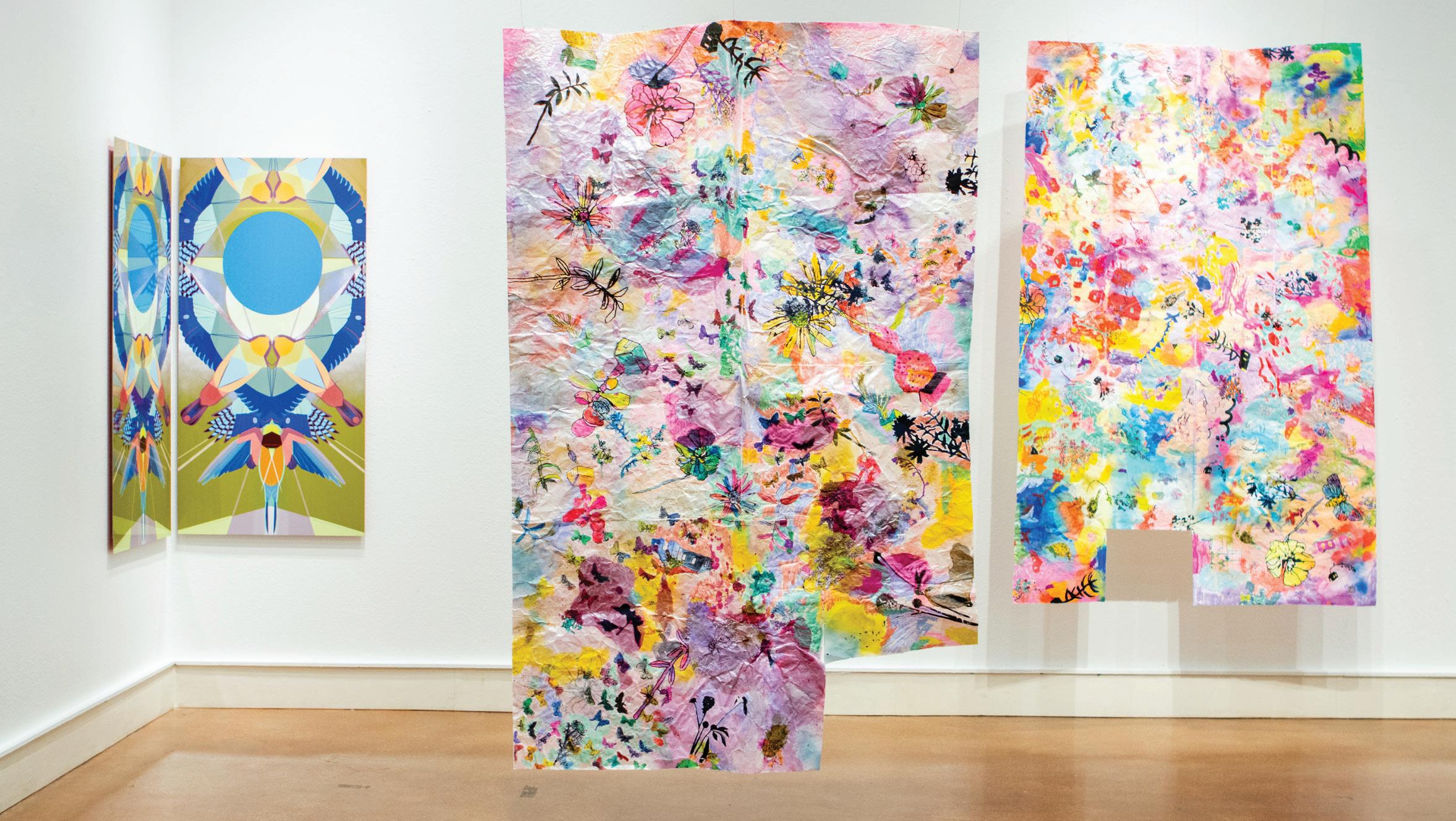
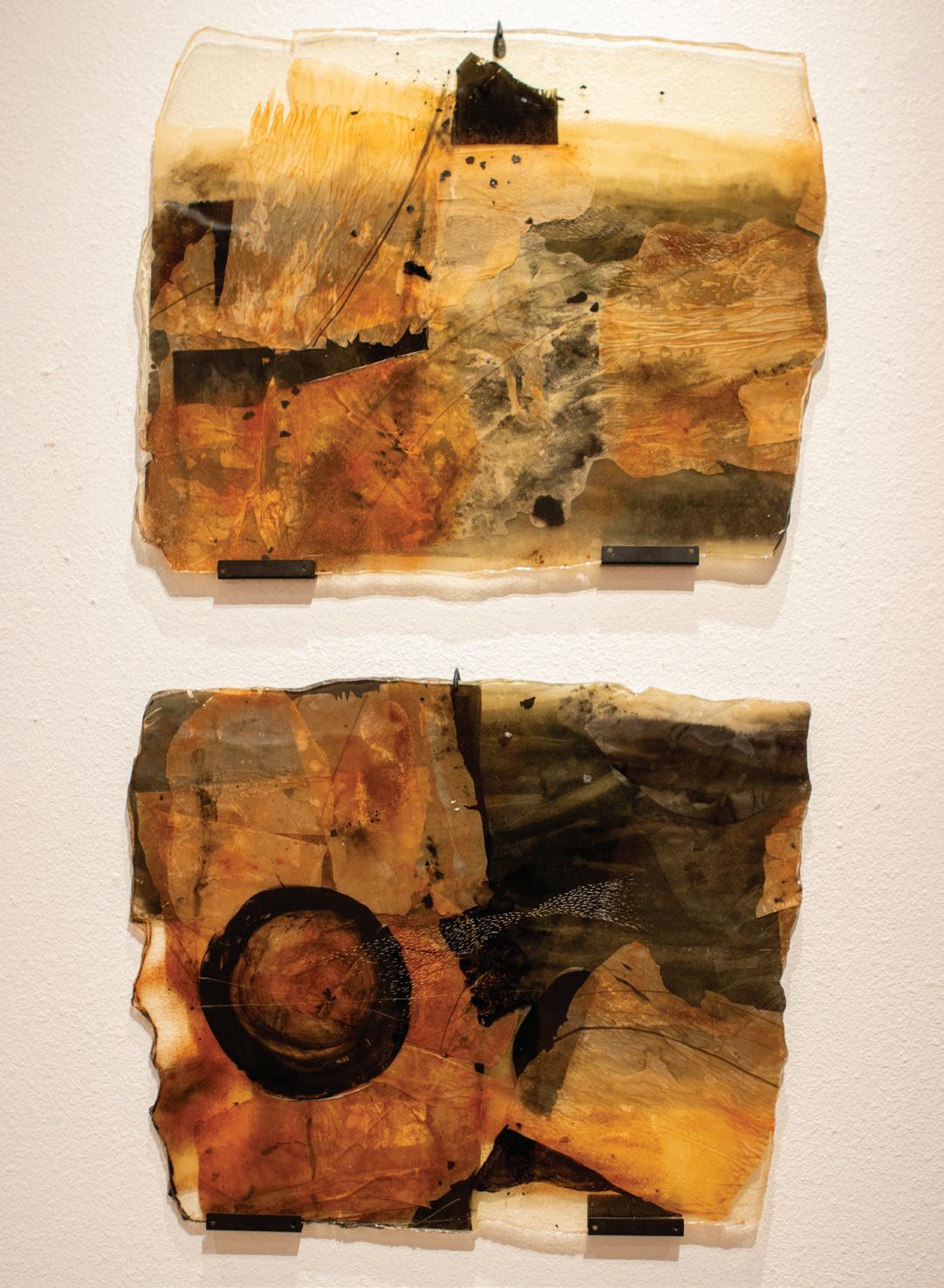
HUDA QURESHI managing editor huda.qureshi@my.tccd.edu Female artists collaborate on vibrant landscape exhibition
The experience of living near the border threads together the artwork of five women connected by their visions of the desert in the “The Desert was Red and Red the Dust was Raised” exhibition, on display on South Campus until Feb. 20.
The conception of the gallery started with the curator, Leslie Moody Castro. She said she wanted to show off the artwork of women residing in the border region, a place with minimal opportunities for female artists. She was having trouble piecing together the work of these artists with varying styles. One day she was reading “All the Pretty Horses” by Cormac McCarthy when she stumbled upon the quote: “The desert he rode was red and
red the dust he raised.” That’s when she realized the location of the New Mexico desert was the connecting piece of each artist’s works.
“The desert dust sort of coats everything, and it’s always present, and it’s kind of this reddish color,” she said. “[Las Cruces is] quite a difficult area to be a full-time artist. It’s small. There’s not a whole lot of opportunities. You have to make a lot of opportunities.”
Castro said she utilizes red to hint at the rebellious act of five female artists succeeding in the tough landscape.
“I think we are moving into a political regime that does not value women or women’s work,” she said. “If there’s anything I can ever do to advocate for women’s work, in the art world and beyond, then I will do it.”
CLUB RUSH swings through tcc
On Jan. 29 NE Campus student organizations came together to host Club Rush, introducing students to organizations on campus. There were refreshments, dance performances and tables run by members of each organization. The event ran from 11 a.m.-2 p.m.
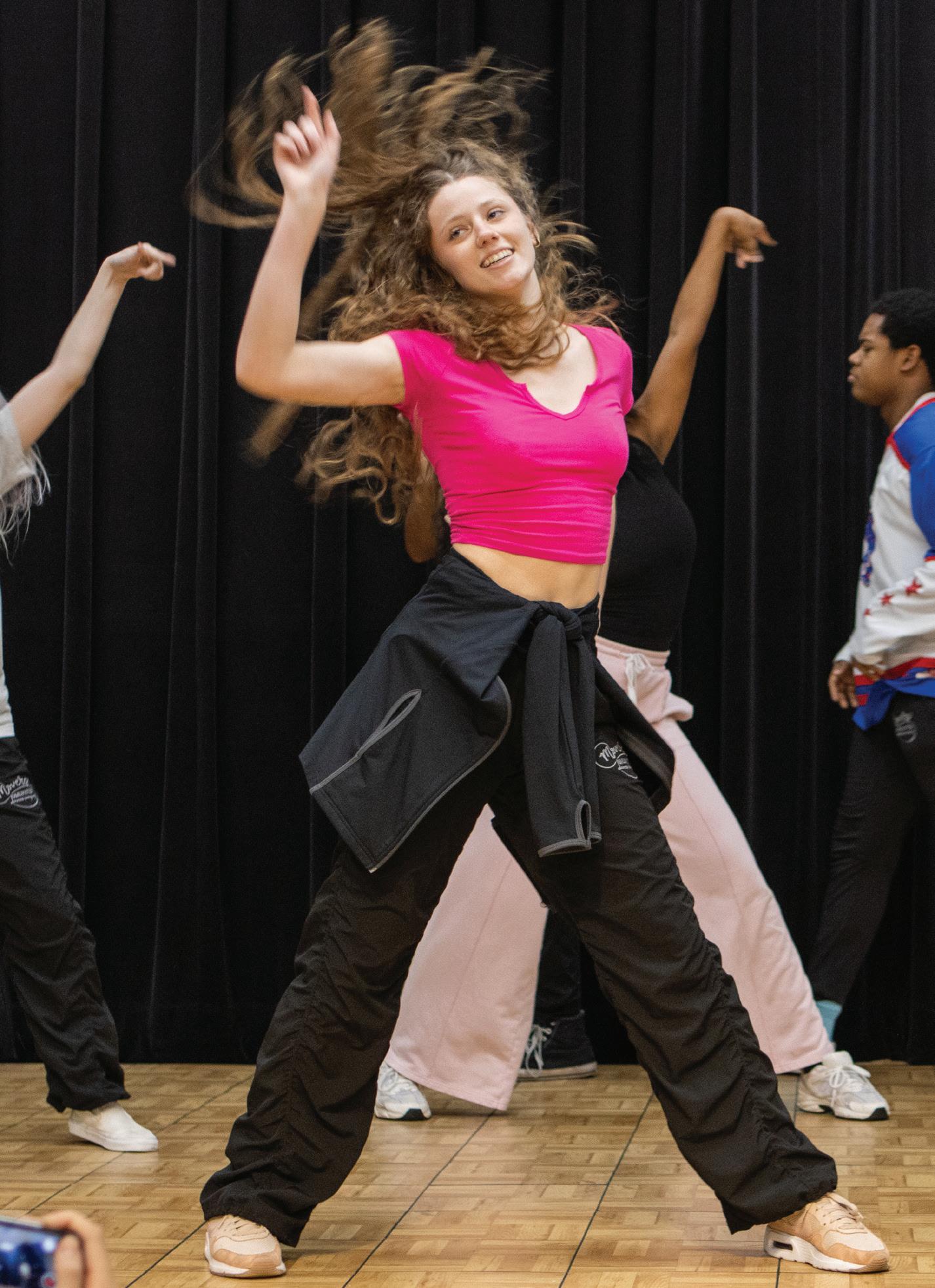
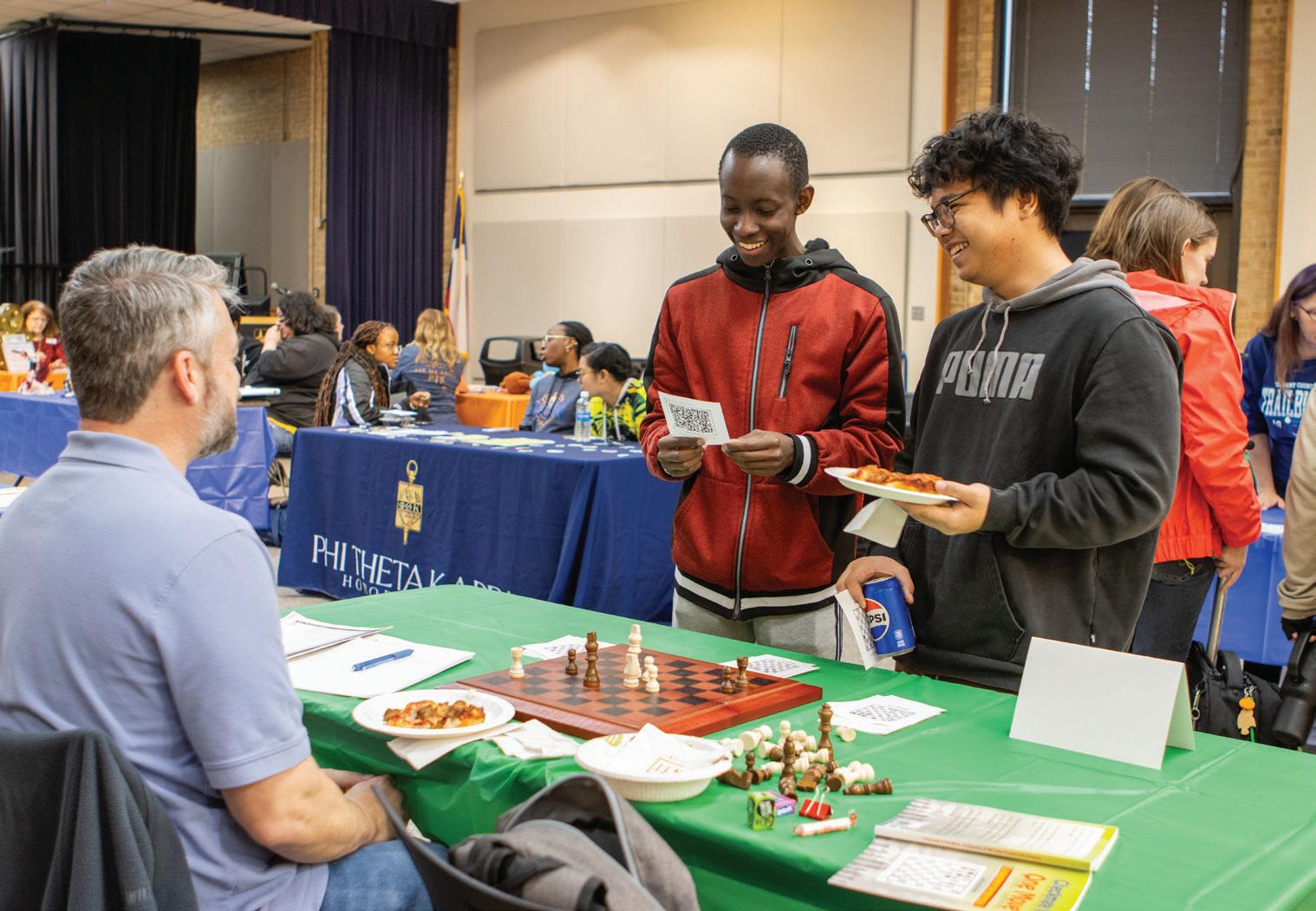
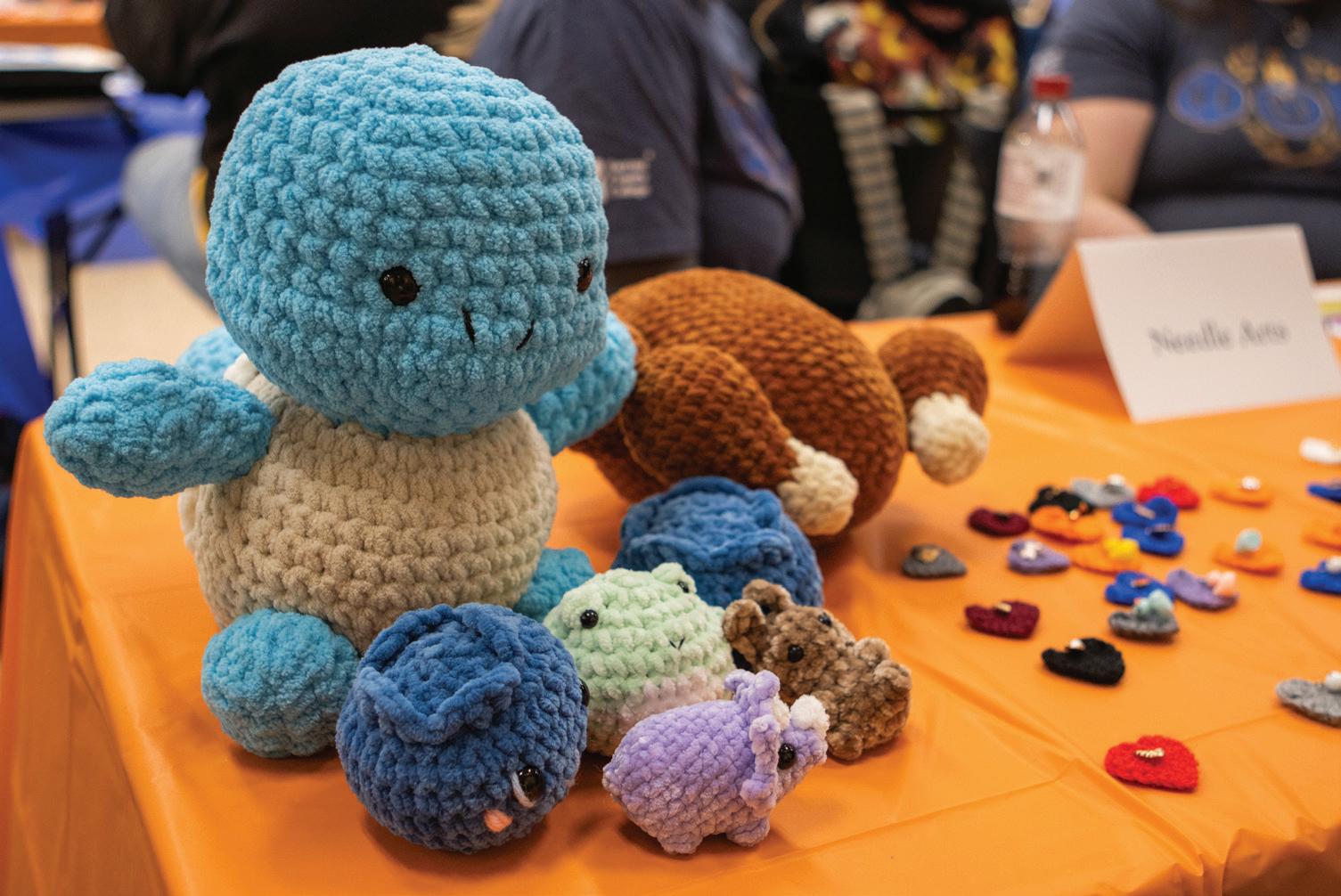
Braille
(continued from page 1)
Guerrero said. “The menus are rarely up to date. Imagine going out to eat with friends and their menus are completely different from yours.”
Guerrero said she wishes people would have a better grasp of how visual impairments play out in the real world instead of relying on media for knowledge.
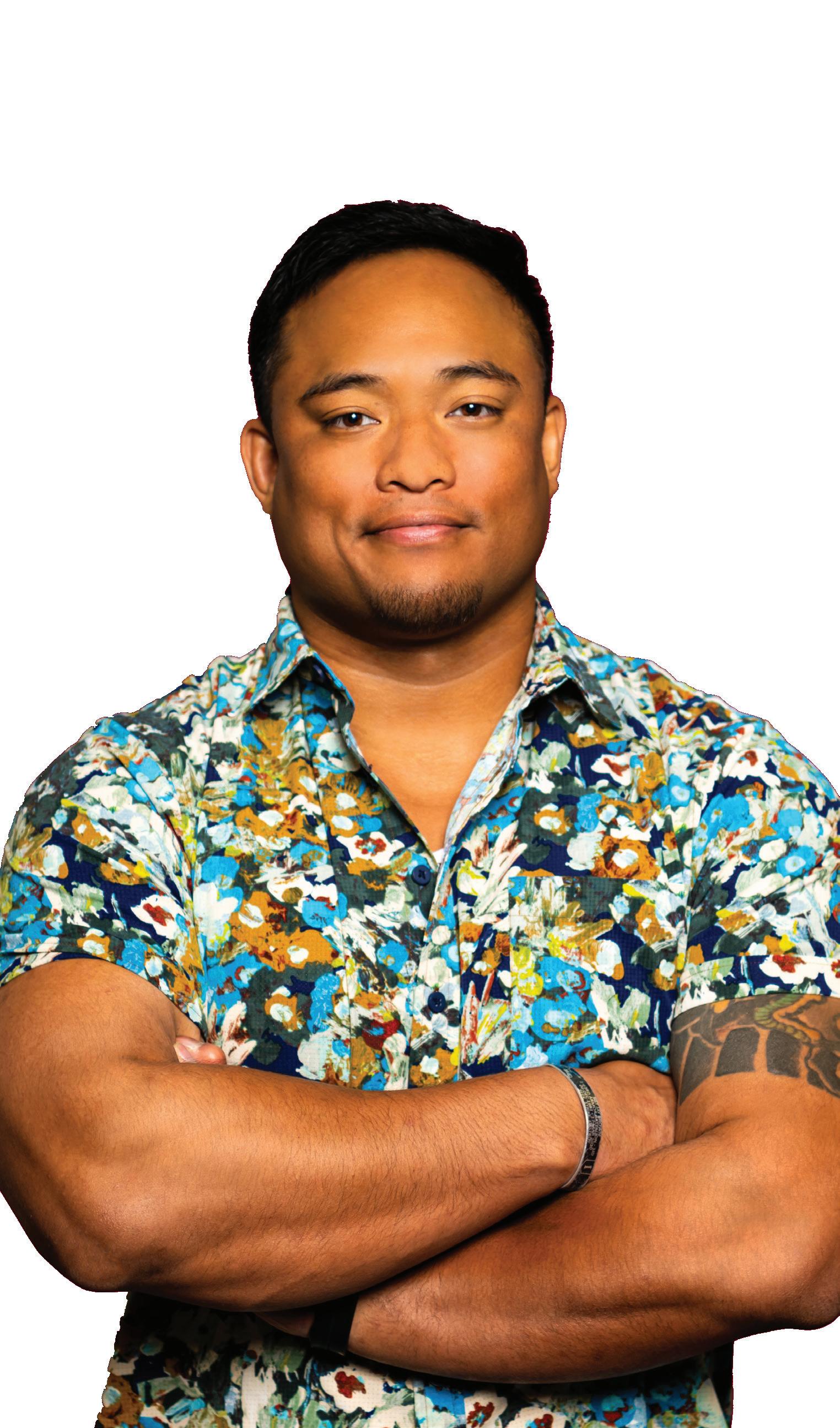
“A lot of people assume everyone who’s blind automatically knows how to read Braille,” Guerrero said. “It’s not like the matrix where it downloads into our brains overnight.”
Guerrero also mentioned “Scent of a Woman,” a movie about a prep school student who cares for a blind, bitter ex-Army officer over a weekend as an example of how media don’t capture real life.
Students and staff can further educate themselves through a variety of resources like National Federation of the Blind, Braille
institutions and Lighthouse for the Blind of Fort Worth.
South student William Scott said he attended the event as part of his responsibility as an employee of the Student Accessibility Resources office, but he left feeling more informed and educated on Braille.
“Honestly, I was not familiar with Braille before this event,” Scott said. “I was surprised by how much technology there is and how expensive it is.”
SAR director Kelli Frederick said this event was important for expanding her knowledge on new resources available for students.
“I think it’s so cool that you can have a computer program and cameras that can read Braille,” Frederick said. “Braille can be the key to success depending on where you travel and where you are in life.”
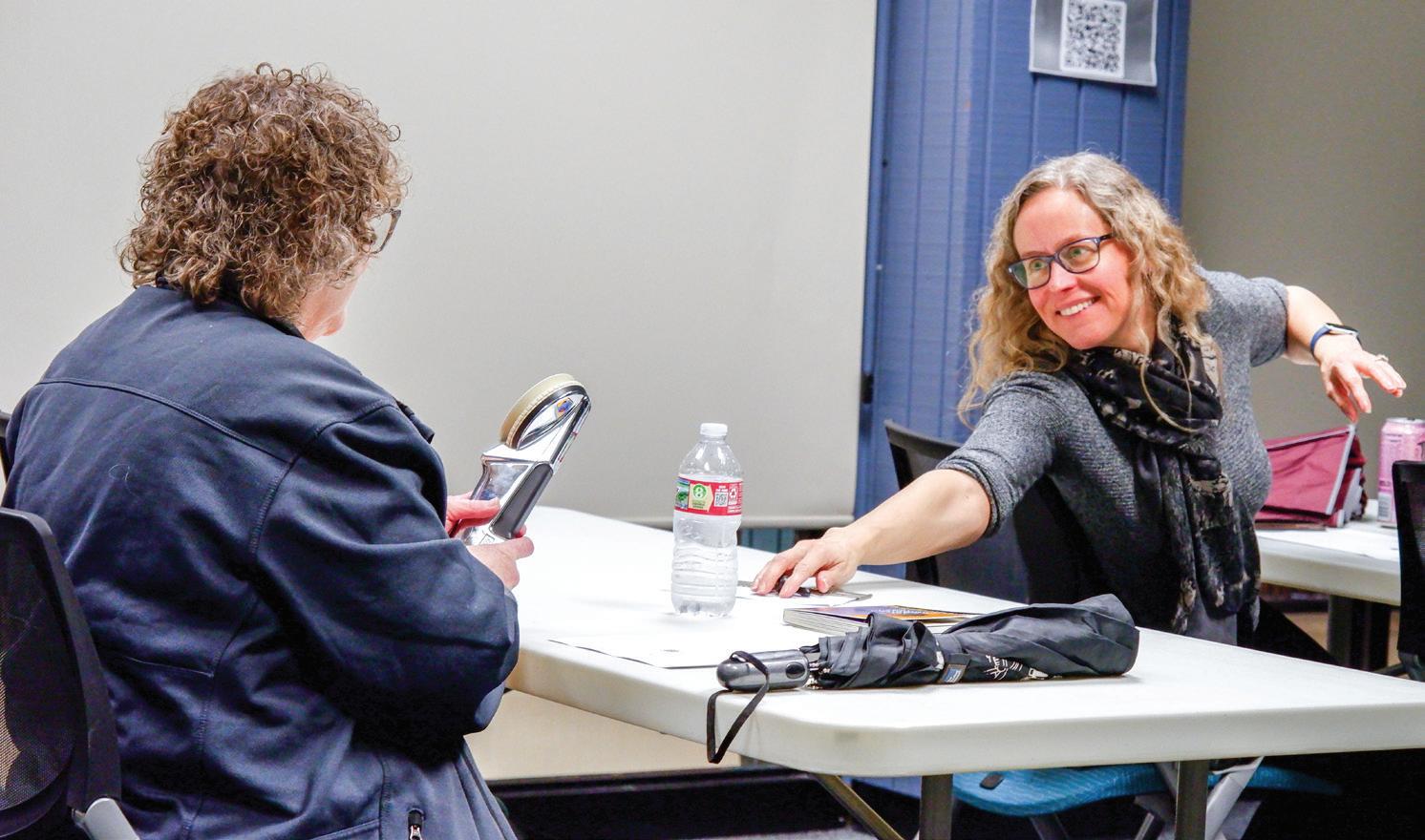
Dual Credit
(continued from page 1)
It also showed that wages go up and unemployment rates go down as workers attain education.
Hicks said dual credit courses will give students more opportunities in life and in their careers.
“They may not have otherwise had an opportunity to either attend college or obtain a college credential, and we know that training past high school is imperative in order for students to obtain a job that allows them to earn a living wage for them and their families,” he said. Martinez said New Heights has already had an impact on its students and they are proud to attend school.
“When they come into orientation, they’re nervous or quiet, they’re shy,” he said. “And I tell them, ‘Now you know how your kids feel when they go to school,’ ... and they laugh about it. But just seeing their excitement for the school. They’re wanting to be here. They’re all here for the
CAMPUS VOICES
Q: “What changes do you want to see with campus dining?”
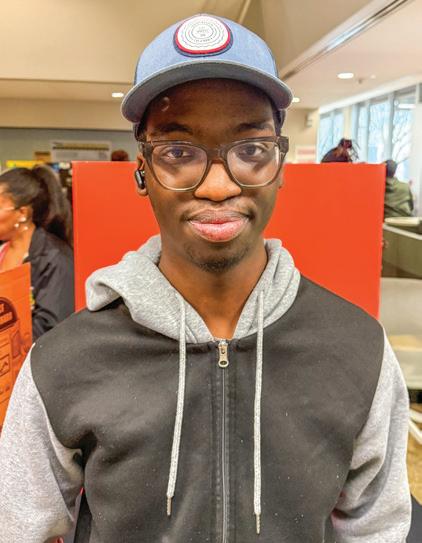
“We have a mini Starbucks ... but the coffee doesn’t even taste good, the pizza is overly expensive and it just doesn’t feel like an actual campus cafeteria ... If we could just put a small branch inside the school that students could just go to and grab a bite.”
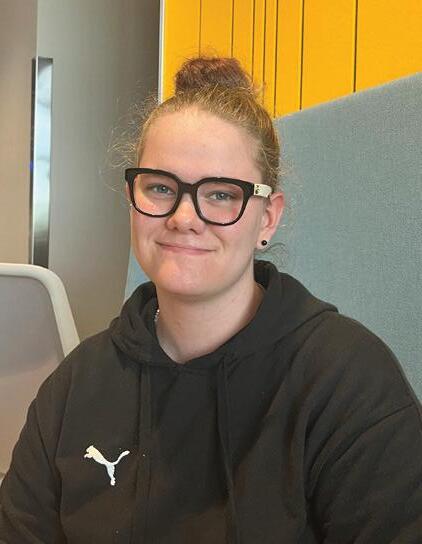
Savannah Pope NW Campus
“I’d like to see something a little healthier besides just sandwiches, maybe more salads. I’m here for three hours in between my first class of the day and my second, and all I’ve been eating is chips, and I don’t want to gain 200 pounds from going to school. There are people who have gluten allergies ... I have a starch intolerance so eating a bunch of chips kills me at the end of the day.”
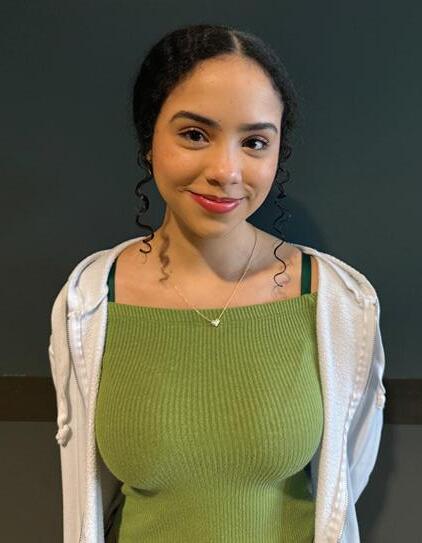
Mia Jimenez SE Campus
“I would like to see more options. I think we’re restricted especially as a community college. We don’t have a dining hall here on the SE campus, and I’d really like to see that implemented.”
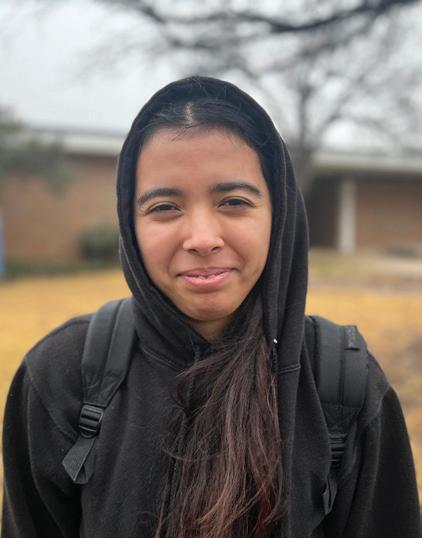
Aliha Flores South Campus
“Not everyone likes pizza and sandwiches. So maybe a lot more healthy options for people who are working on their diet or ... exercising and care about the way they look, and are trying to work on it.”

“Juice options is a good idea to bring into the dining hall because we have nothing but coffee, energy drinks and sodas in there.”
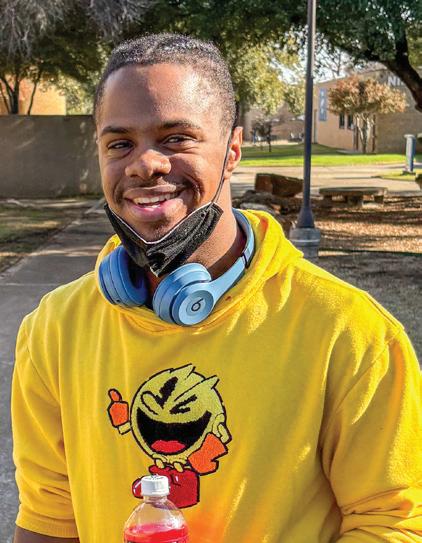
“I do like what they have already but seeing maybe tacos or something like that. Like beef tacos, cheese tacos, chicken tacos, steak tacos, I think that would be nice. A slushy machine,or an ice cream machine would be cool.”
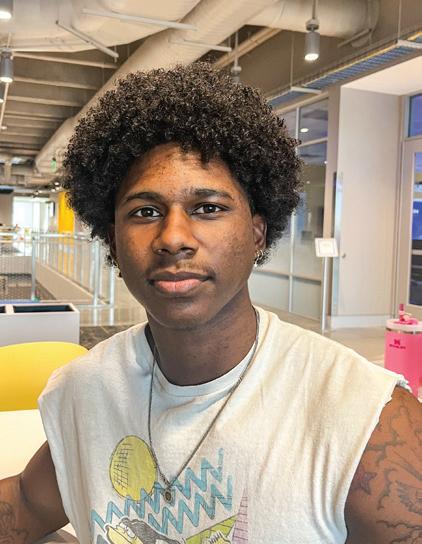
Brian Tanner NW Campus
“I honestly didn’t know we really had food. I’d like to see something quick that I can grab. Sometimes I’m running late to class, and it would be nice to have something that I could quickly grab and go.”
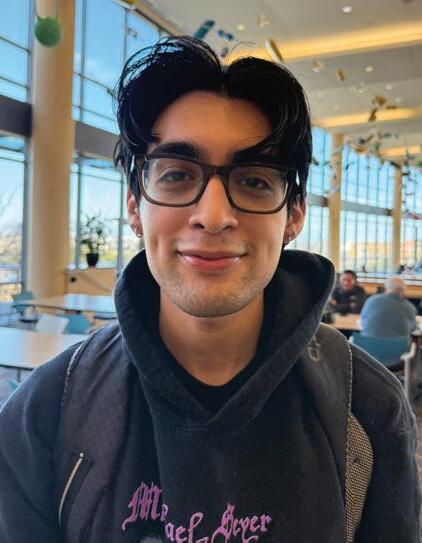
“I wish it was open longer. It’s always closed by the time I’m ready to eat because all of my classes are later in the day.”
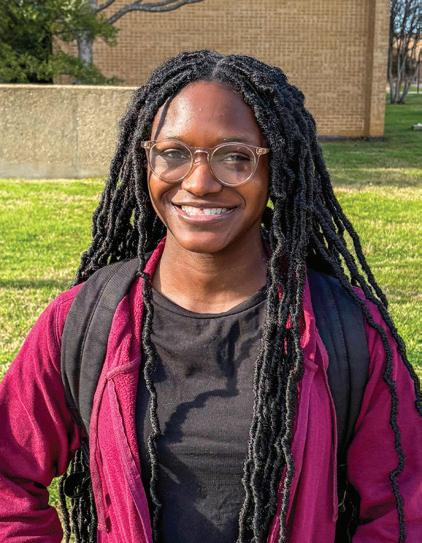
“I don’t really eat on campus, but if I did, I’d definitely want more incorporation of fruit. That way, everybody can have good fresh fruit in their diet. I think they should extend the hours a little bit longer. Maybe until like 6-7. I know if I was coming to class later and I couldn’t get a meal, it would be tough. Extending the hours would definitely help the students.”
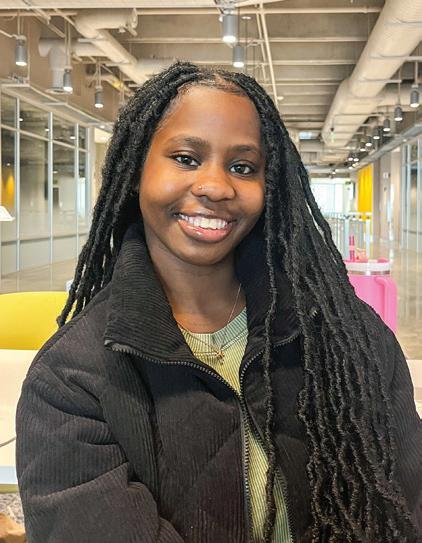
“I’d like to see students get meal cards where they put money in it like other colleges, and you swipe it and they have food made like burgers, or something simple. When you’re fueled good and you’ve eaten good, you can do better in tests and just focus more in class.”
TR: An invasive recording inside a bathroom or changing room was reported inside the trinity building. This case is under active investigation. South: An assault
‘The Brutalist’ moves viewers, critics
Stunning historical film depicts how immigrant talent is exploited
FRED NGUYEN campus editor collegian.editor@tccd.edu
From the very first, claustrophobic scene of a man maneuvering through a busy ship’s hold, Brady Corbet’s “The Brutalist” revealed its theme through our first look of 1940s America — the Statue of Liberty upside down and on its side.
In the style of the epics of the ‘50s and ‘60s, memorable shots like these take your breath away.
In David Lean’s “Lawrence of Arabia,” it was the great expanse of orange sand dunes and blue skies pictured in ultra-wide shots. In “The Brutalist,” the cool blues and gritty dark tones of a dirty, industrialized Philadelphia send a chill through you.
Filmed with 35mm film stock using a process engineered in 1954, “The Brutalist” tries to capture the aesthetic and novelty of the historical epics but doesn’t lose its identity as a truly modern movie.
The film follows the journey of Hungarian-Jewish Holocaust survivor and architect László Tóth, played by Adrien Brody, who emigrated to America in the late ‘40s to look for work and, like many immigrants, a better life.
He left behind his wife Erzsébet, played by Felicity Jones, and his niece Zsófia and spends the first act looking for work and a way for them to join him.
Tóth’s life in America is filled with equal parts tragedy and pleasure.
The first act is almost perfect in how it establishes the contrast of the dirty streets of a poverty-stricken city and the isolated grandeur of the Van Buren estate.
Clocking in at about three and a half hours, the audience is sucked into an odyssey spanning more than two decades featuring some truly great acting.
Almost every performance in this film is compelling and memorable, which can be hard to achieve in an epic with a big cast. Brody and Jones give standout performances as the Tóths.
This isn’t Brody’s first time playing a Holocaust survivor in a film that leaves audi-
BOOK REVIEW REVIEW
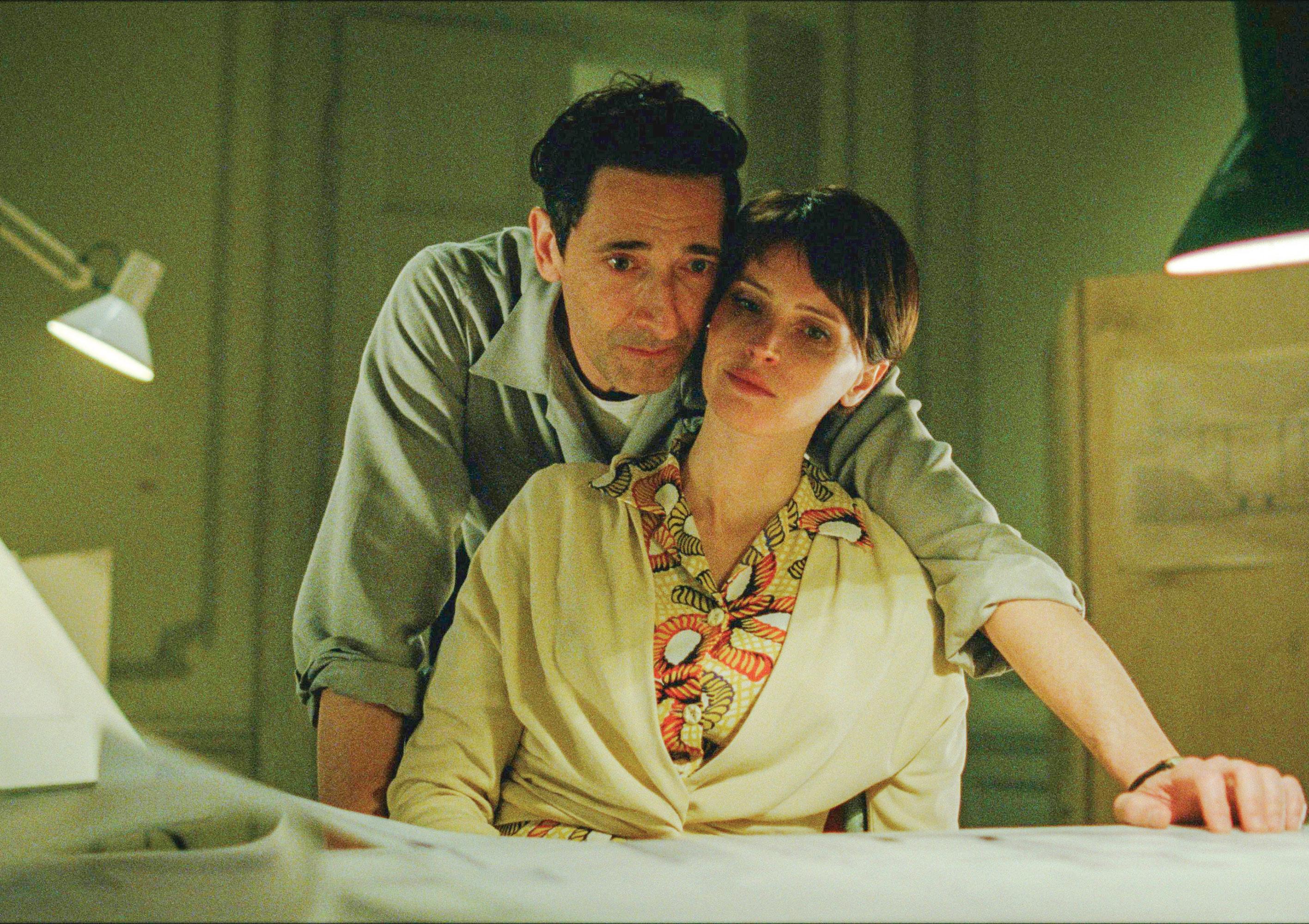
ences emotionally drained. In 2002, he had portrayed a real-life musician in Roman Polanski’s “The Pianist” for which he became the youngest man to win the Oscar for best actor at the age of 29.
For Brody’s performance in “The Brutalist,” he is likely to win another one. Jones plays the character with the most determination and mental fortitude. Her devotion to both her own dignity and to the life she wants for herself is displayed through Jones’ powerful performance.
The Tóths’ tumultuous but ultimately
earnest love for each other is at the core of the film’s message of how America uses and spits out its immigrants.
Of course, the film does have its faults. It is, at times, too ambitious. Even at more than three hours, the last act tries to wrap up the story in too little time when it deserves more to end naturally. This is the hard part of making an epic: knowing when to end a story after hours of building it to its climax.
The film’s reputation also took a hit after it was revealed that the voices of some of its stars were edited using an AI program in
post-production. This was done to apparently improve the authenticity of the Hungarian accents, but the decision has proved controversial as the film industry wrestles with the use of AI. In spite of its faults, “The Brutalist” still succeeds in leaving a lasting impression in those who see it. And after the credits roll, the images of the symbol of American liberty turned on its head will remain for a long time.
Pope Francis explores faith, resilience in new book
DIEGO COLLAZO campus editor diego.collazo@my.tccd.edu
“Hope,” the first autobiography by a sitting pope, explores the role of faith, compassion and resilience in a world filled with suffering and uncertainty.
Rather than discussing abstract subjects, he speaks directly to the reader, sharing personal stories, reflections and biblical wisdom. The pope touches on a variety of topics, from immigration and poverty to leadership, war, drugs and everything in between.
I was drawn to this book because Pope Francis is a fascinating figure. I wanted to understand his perspective on hope, especially in times when things can feel hopeless.
Pope Francis doesn’t merely define hope, but he exemplifies it through personal anecdotes, biblical references and reflections on global issues.
He illustrates how hope can steer individuals and communities toward a better future. He emphasizes the significance of forgiveness, the dangers of indifference and the duty of leaders to serve their people with integrity and humility.
One of the book’s biggest strengths is its descriptive storytelling. No detail is too small.
Whether he’s discussing his early days in Argentina or reflecting on the horrors of war, the pope’s words paint a vivid picture that makes it feel like you’re having a one-on-one conversation with him. His writing is also deeply humble and accessible.
He may be the pope, but he wants to be

with thousands
Pope Francis
seen as an ordinary person.
The highlights of the book are the unexpected touches of humor, his elite sports knowledge and love for soccer and basketball are clear, his appreciation for classical music and tango and even the small confession that he hasn’t watched TV since 1990. These details make him feel less like an untouchable religious figure and like your next-door neighbor.
For all the book’s depth, Pope Francis does hold back on his emotions at times.
He shares stories of the immense loss of his father, mother and siblings but rarely dwells on how these moments shaped him. He acknowledges crying a few times, but the lack of depth regarding his grief leaves a lot to be desired. Another challenge is the book’s loose structure. He jumps between childhood and adulthood, past and present, sometimes without clear transitions. While this keeps the book engaging, it can also make it feel scattered at times.
Additionally, I would have liked more insight into his journey to becoming pope. He touches on his path within the church but doesn’t go into as much detail about the transition from priest to cardinal to pope, which could have been fascinating.
Reading this book made me feel a closer connection to God and a deeper understanding of the Pope’s worldview. His message that “God is in all things” really stood out to me. It’s a reminder to find faith in everyday moments, not just in grand religious experiences. Perhaps the most powerful takeaway is that hope is not just optimism, it’s action. Pope Francis reminds us that real change comes from those who refuse to be indifferent. His words challenge us to not just believe in hope but to live, breathe and be a beacon of hope.
Hope blends faith, history and personal reflection in a way that feels profound and intimate. While the structure can be a bit scattered, the depth of wisdom and humanity in Pope Francis’ words make it a worthwhile read.
Pope Francis speaks to universal themes, compassion, resilience and justice that extend beyond faith. Whether you’re struggling with personal challenges or just looking for a new perspective, this book offers something meaningful.
So, should you read Hope? Well … is the Pope Catholic?
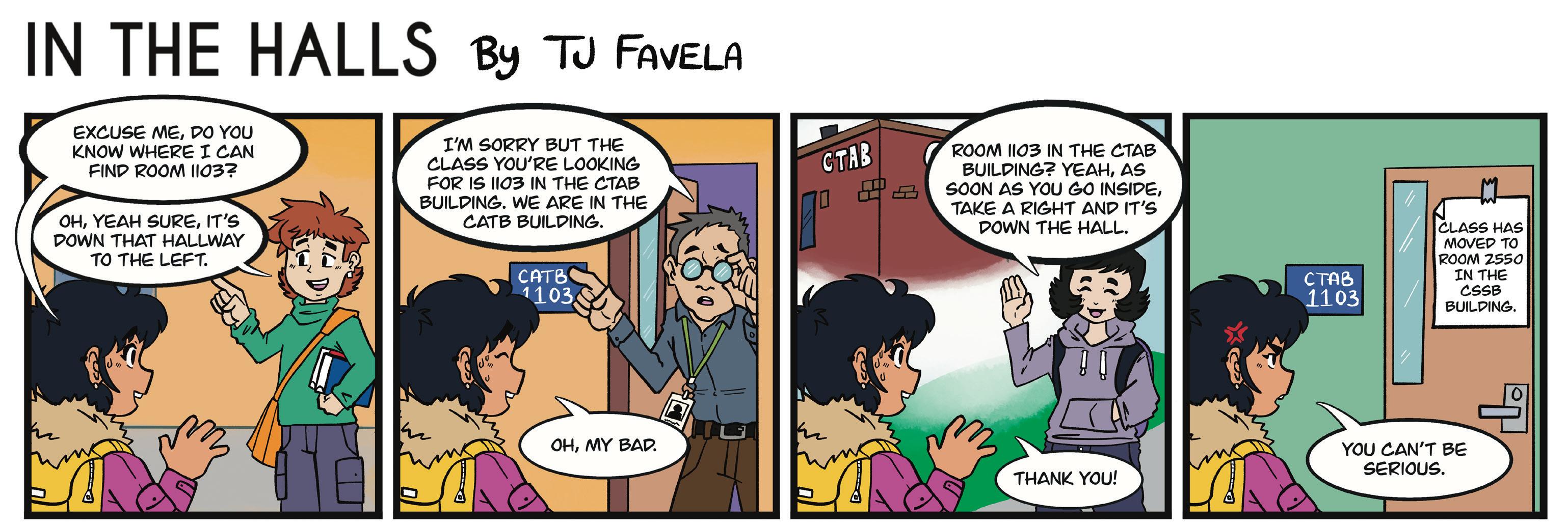
Trump’s anti-trans policy protects no one
America is built on the promise of liberty and justice for all. But if you deviate from prejudiced standards created by those with enough money and status to avoid the repercussions of their unjust actions, it doesn’t apply.
The conservative community relies on fear of the “other” to function. They need a scapegoat for society’s failure to uphold traditional values, which allows them to justify a lack of empathy for their fellow human beings.
One of the main groups conservatives have chosen as the big bad “other” right now, is the transgender community. The manufactured outrage in the name of protecting women and children is pushing society into an intolerant mess. It riles up the conservative voter base, so they can maintain power.
Trans people, a heavily disadvantaged and marginalized group, have become the Trump supporter’s “boogeyman” responsible for ruining traditional American values. To them, women and children need to be saved from these dangerous ideas at all costs, even if it means they’ll be harmed in the process. To maximize the efforts to remove protections for trans people in the United States, Trump signed an executive order titled: “Defending women from gender ideology, extremism and restoring biological truth to the Federal Government.”
It’s full of unscientific statements, fearmongering and a total lack of
empathy for trans individuals.
A big talking point in the document is the safety of women, implying that trans women are all predators out to harm cisgender women. Looking at the statistics, trans women are in more danger of being victims of violence than inflicting it. According to UCLA Williams Insititute of Law, transgender people over 16 are victimized over four times more often than cisgender people.
In the name of protecting them, the anti-trans legislation will prevent women from seeking care at women’s health these clinics as the care they offer at clinics often overlaps with trans healthcare. As these clinics lose their funding, the women who were kept “safe” by this order will be left without vital resources.
The cover-up of cis women’s safety is used to criminalize trans and gender-nonconforming individuals with the underlying message: “The trans community needs to stop existing in the United States.”
Another argument is “biological reality”, which dismisses and warps scientific evidence with definitive language such as: “These sexes [male and female] are not changeable and are grounded in fundamental and incontrovertible reality.” There’s no consideration of the complex and ever-changing nature of science and how it relates to the endless ways to experience gender.
The widespread acceptance of closed-minded beliefs when it comes to gender is indicative of a society that is moving backward.
Back in the day, we watched everything on a cable box. Now, we can simply download an app to our favorite network to stream our favorite shows or movies.
What started off as a more convenient option has turned into a nightmare, leaving most drowning in subscription fees. We’ve now reached a point where we have too many streaming services.
Several platforms over the last decade have come out with their own streaming sites. Each one claims to offer something unique by having its own exclusive shows, pricing models and apps. What once started out to be cheap has now become pricier.
If you want to watch anything Marvelrelated, you can only watch on Disney+. Netflix has Stranger Things, Squid Games and many more shows and movies that are popular. Other platforms have their own
To combat a healthcare system designed for profit, many have turned to “experts” for unorthodox health tips and tricks secretly motivated by the same capitalistic goal.
Following the assassination of Brian Thompson, United Healthcare’s CEO, stories resurfaced of customers who were denied coverage of necessary daily medication and lifesaving procedures.
Anthem Blue Cross Blue Shield’s most recent decision to limit its anesthesia coverage was quickly reversed after facing heavy scrutiny. However, regardless of whether it was implemented, this move reminded the American public of the insurer’s overt, greedy ambitions.
Studies published by the U.S. National Library of Medicine, the American Economic Association and The New England Journal of Medicine show significant markups for prescriptions and specialty drugs, with the latter listing a 300% markup in some cases.
Policies aimed at minimizing prescription costs for those on Medicare or Medicaid were demolished days after the new presidential inauguration.
To avoid crippling medical debt, many look to holistic products and techniques as a preventative measure or treatment alternative.

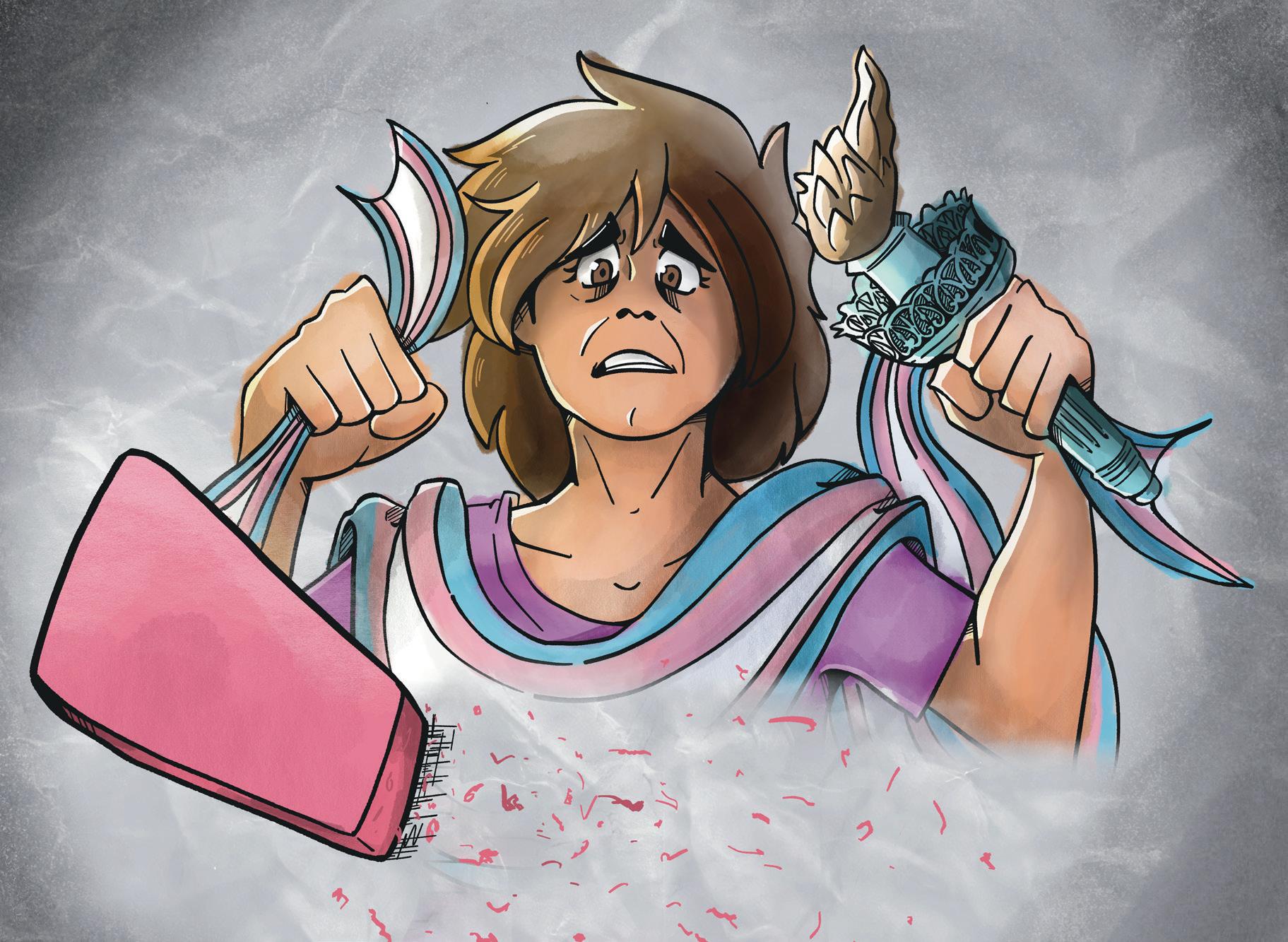
There’s a fixation on trivial things, such as trans women simply using the restroom, ignoring the fact that there is no empirical evidence of trans women posing a threat to cis women in restrooms. The sentiment is purely based on a mix of ignorance and hate.
According to the World Population Review, only 0.52% of the adult population identifies as transgender in the United States. The small population size allows conservatives to effectively target
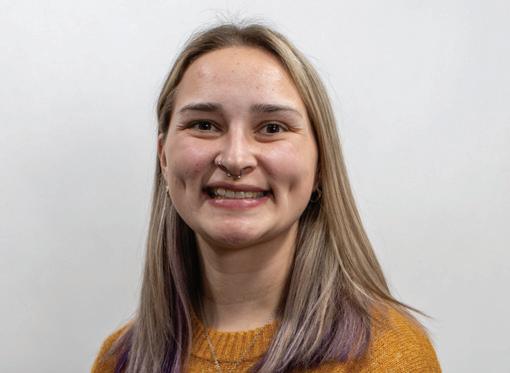
CHEYENNE SHAWN campus editor cheyenne.shawn@my.tccd.edu
original series you can only watch on their sites. Once upon a time, you could reasonably cover your entertainment needs with just one or two services. Now, the options are endless with Disney+, Apple TV, Peacock,
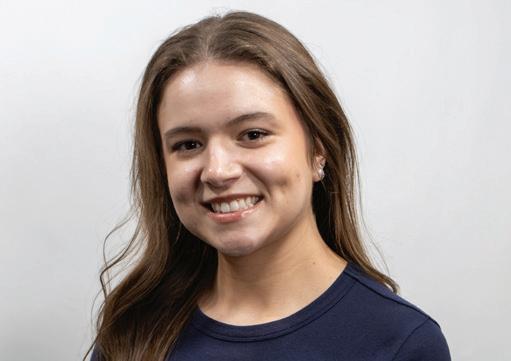
LAUREN HARPER multimedia editor lauren.harper903@my.tccd.edu
Unfortunately, where those trying to better their health see possibility, others see vulnerability, desperation and opportunity for capital.
During my brief time in retail selling supplements, customers frequently asked for herbalist solutions because they couldn’t afford their doctor-recommended prescription, or more alarmingly, completely lost trust in the medical industry to prioritize their well-being.
I saw, first hand, employees encouraged to spot vulnerabilities among customers and discourage them from using prescribed medicine to increase the day’s net sales.
the trans community as the “other” responsible for all the problems preventing the existence of a conservative utopia. The place where women stay quietly behaved and no one deviates from repressive ideals. It’s also more difficult to organize and protest unjust actions on a large scale without substantial support which makes it harder for the trans community to resist the uptick in discrimination from Trump supporters.
Paramount+ and a dozen others. Movies and shows that aren’t originals or exclusive to that platform tend to rotate through each service. It can be frustrating trying to figure out what service they are on and if you have that subscription.
It seems as if these businesses are just being greedy. They’re either constantly raising the price or being stingy with password sharing. In 2023, Netflix cracked down on the issue requiring users to log in from their home IP address. If you want to add another location, you get charged for it. Some could say that these services are losing money by having one person pay for it while several others are using that account.
Netflix, the major villain for raising prices what seems like each year. 2025 is barely a month old, and we’ve already seen it happen this year. The basic subscription
However, consumers fail to realize that often the organization crowning itself as the more ethical alternative is using society’s growing fear of medicine and its power to weaken logic, to expand their net worth.
This isn’t to disparage natural supplements or holistic healing approaches. There are clinically studied vitamins, minerals and herbs that can help ease minor health concerns. Still, independent research into the product’s effectiveness and the advice of medical professionals should be taken into account.
Social media has spearheaded the trend of profiting from people’s weaknesses while spreading misinformation. Its accessibility and lack of regulation make it a breeding ground for sharing conspiratorial health facts and promoting products and seminars. This has blown up on the nutrition side of various social platforms. Influencers are pushing potentially dangerous lifestyle changes with claims that they could cure chronic and immune diseases.
Recently, unpasteurized milk and animalbased diets have circulated the health and wellness space, promising that raw dairy and the absence of fruits and veggies could eliminate bloating, balance hormones and regulate insulin levels.
Promoting these changes blatantly ignores



Education can play a big role in how people think about marginalized groups. The lack of basic empathy for trans people is difficult to combat but debunking the propaganda being pushed right now can be an important step. Often, simply having a sincere conversation with a trans individual can shift hateful views. Standing up to injustice requires persistence, but it is necessary and possible because the trans community will always have a place in the U.S.
including ads is now close to $20. As they continue to raise their prices, their content seems to be going downhill. It’s not uncommon to hear how they’ve canceled yet another show that has maybe one or two seasons. It’s not just Netflix. Other services are rolling out similar models with low introductory rates, creating a dependency for the shows you love only to later jack up the price.
Rather than one hub for content, we’re forced to juggle multiple subscriptions. It would be nice if a bundling option were made available to help bring costs down. For instance, Disney+ offers a bundle deal that includes it with Hulu and ESPN. As a consumer, I wish streaming services would hear these concerns instead of worrying only about their bottom line.
the evolution of food safety and dietary science. It puts their audience in danger of viral diseases like avian flu and life-threatening neurological disorders should they choose to follow the advice.
We’re already witnessing the consequences of these practices in the form of severe nutritional deficiencies, high blood pressure, cholesterol and restrictive diets that demonize entire food groups.
These posts usually end by discrediting the research that counters their claims, and labeling those who continue following a more traditional nutrition plan as brainwashed sheep.
Unfounded claims are then accompanied by a pitch to sell a book, training course or supplement, highlighting the influencer’s main goal: to act as an authoritative source for a sensitive topic such as one’s health to fear-monger, belittle and proclaim the solution can only be found through them.
This manipulation method of offering a grand escape to a seemingly impossible situation isn’t new. It’s used on a much grander scale with cults recruiting those desperate for a better life.
These predatory tactics on the sick and fearful are dangerous and unregulated, and those responsible should be held accountable for the inevitable repercussions.
EMOTIONS OF THE desert
Five women create abstract art to explore border region
Desert
(continued from page 1)
Creating freedom beyond borders
Stepping into the gallery reveals various colorful art pieces in different mediums, including a couple of almost 7-foot mixedmedia paintings on rice paper hanging from the ceiling by artist Isadora Jackson.
Jackson teaches painting, drawing, design and art history as a professor at El Paso Community College alongside her career as an artist. Her work in this exhibition consists of large pieces of rice paper sewn together with different layers of painting and drawing on top of it. She said the process of creating the work was freeing and joyful.
“We live on the border,” she said. “We have all these delineations. But how do you push through those? How do you create your own reality? That was kind of the inspiration for this work, and I wanted to branch out into something I hadn’t done. And this was the kind of safe, supportive space to kind of debut that work.”
Nature, mathematics are intertwined
Zoe Spiliotis is also an art professor at El Paso Community College and has her work displayed in the exhibit. Her works use mathematical principles in their compositions including symmetry and reflections.
Her work depicts various natural elements such as the moon, sun and birds. She said the meaning of the work can be different for each viewer. Looking at different parts of it such as the colors and shapes can cause the context and meaning to change.
“It’s like a larger kind of philosophical thing, that we see things from one perspective, our own, but it’s hard to put ourselves in somebody else’s shoes,” she said. “So, when you are focused just on shapes and colors, that transition can really happen.”
Art is impacted by politics
Artwork by Sharbani Das Gupta in the exhibition consists of two suspended discs made of glass
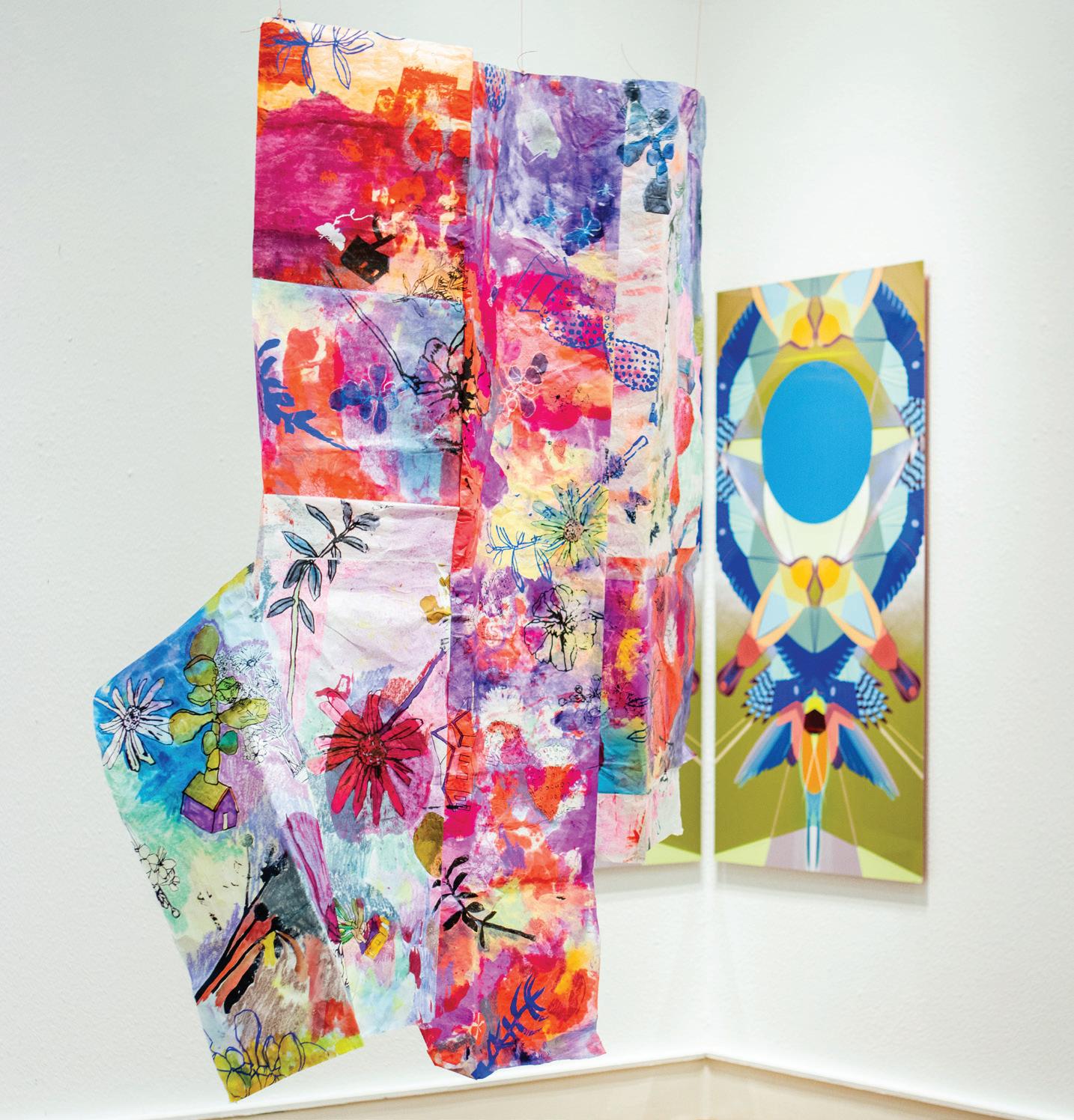
Isadora Jackson’s “Soil and Sky” made from acrylic paint, ink, thread, screenprint and drawing on rice paper (front) and
in the Sky Without End” made through digital drawing on metal with mixed media (behind). The exhibit featured five women artists from New Mexico.
and bullet-perforated iron scrap along with a couple of multimedia works. The work with the suspended discs is called “Assaulted Earth” and was inspired by the George Floyd protests.
“I was thinking about the after effect of conflict and how what we are left with as humans is really sorrow and the weight of tears,” she said.
Gupta was born in India but has lived in New Mexico for the last 25 years.
She was trained as a graphic designer but transitioned to working primarily with clay.
“It’s been interesting working here on the border, where we talk about so many issues that connect to my life as an outsider; becoming part of another
country, assimilating, learning to live as an immigrant and yet still maintaining a very close contact and connection to my home country,” she said.
Experimenting with landscapes Amy Vensel is an artist in the exhibition who is inspired by the landscape around her. When she settled in New Mexico after moving from the East Coast, she found beauty in the desert.
“Out here, I can see the sky and the light, and that feeds into the colors in my work,” she said. “If you look at the paintings, you might be reminded of the soft gradients of color of sunset or rays, of light filtered by clouds.”
Vensel tapes off her paintings into different sections and works on each
section independently, experimenting with color, shape and texture.
“I’m setting up a puzzle for myself in which I create something unknown and then figure out how to make sense out of it,” she said.
When looking at her work, Vensel intends for the viewer to see it as experience rather than hint at any sort of meaning. She embraces the undefined quality of abstract work.
“It’s sort of like an unknown that people can agree on that they’re drawn to like how people are drawn to interesting clouds,” she said. “It’s more of a universal feeling. I like that idea that you might not know what it is, but it’s exciting to you, and you like it, and you’re drawn to it.”
The process of making art is magical for Vensel and she said anything can happen when she starts creating.
“I don’t have a preconceived notion of what I’m going to make,” she said. “When I start a painting, it’s usually I just start with a color. It is endlessly surprising and fascinating what happens.”
Finding joy and purpose through art Jackson said she wants people to experience joy as they look at the artwork. She wants to give them a moment of reprieve as the world becomes harder.
“I’m trying to do that with the color, with the brush strokes, with the shapes,” she said. “I’m trying to meet this kind of atmosphere and universe in the work that helps people feel like they can enter it and it’s this place that that keeps you and holds you.”
Spiliotis used to teach drawing and art appreciation at TCC South Campus in the past. She said it was exciting to loop back to where her professional career started. Her advice to students is to remain true to themselves and find their own voice.
“You can’t chase what’s popular or chase trends,” she said. “You really have to find your own way of creating and making art, and that is what will sustain you over your career, and it’s going to be what’s most fulfilling.”

Vensel’s
